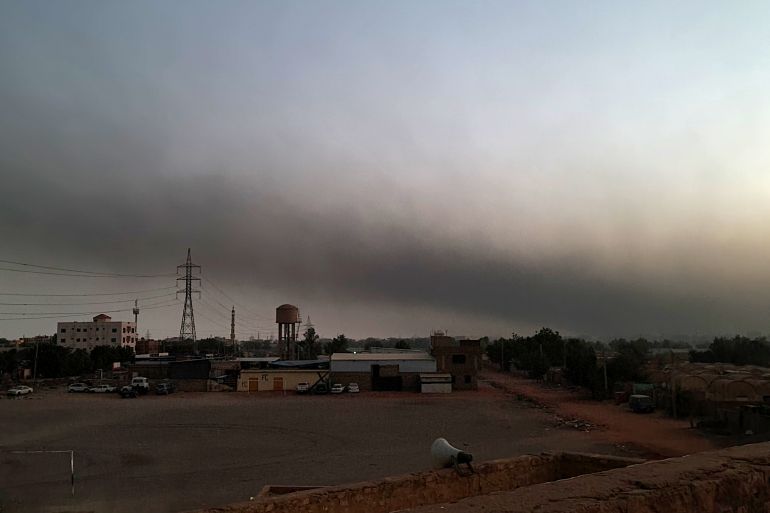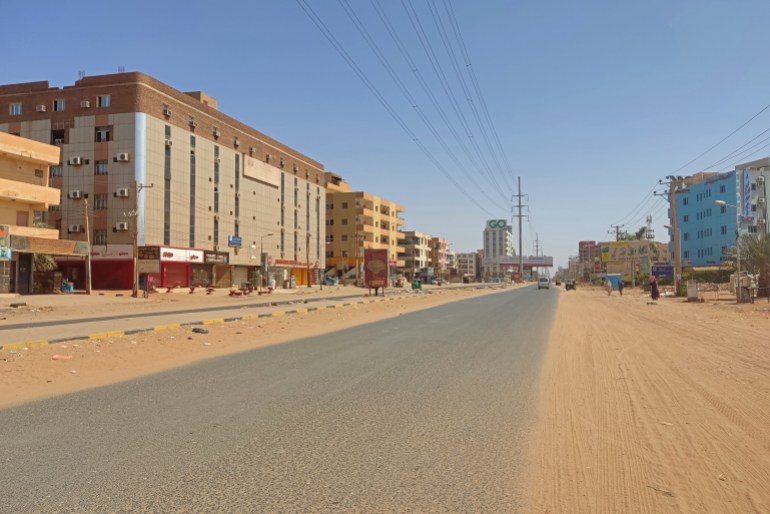Fighter jets and artillery fire mark first day of Sudan ceasefire
A weeklong truce brokered by the US and Saudi Arabia and designed to allow the delivery of aid is at stake as residents report ongoing fighting.

Residents in Khartoum have reported artillery fire and warplanes flying above Sudan’s capital less than a day after an internationally monitored ceasefire came into force.
The weeklong truce to allow for humanitarian assistance to be delivered officially began at 9:45pm (19:45 GMT) on Monday after five weeks of fierce battles between the army, led by Sudan’s army chief and de facto leader Abdel Fattah al-Burhan, and the paramilitary Rapid Support Forces (RSF), commanded by his former deputy Mohamed Hamdan Dagalo.
Keep reading
list of 3 itemsSudan cannot afford to reject foreign help
Sudan’s army, rival paramilitary force sign week-long ceasefire
Although fighting had continued through previous ceasefires, this was the first one that the army and RSF had signed after negotiations, raising hopes of a successful halt to a conflict that has driven nearly 1.1 million people from their homes since April 15.
However, according to Al Jazeera’s Hiba Morgan, residents in the eastern part of Omdurman, the city that lies across the Nile River from Khartoum, have been forced to remain indoors due to ongoing heavy artillery fire.
“We were also able to see plumes of smoke rising from the central part of the capital, and we could hear fighter jets flying overhead,” she said from Khartoum on Tuesday.
Residents said that “from the moment of the ceasefire … they were able to hear heavy artillery. They said from the very beginning of the ceasefire, it was already violated by both sides,” she added.

Khartoum, Omdurman and Khartoum North make up Sudan’s greater capital area. They are separated by the confluence of the Blue Nile and White Nile.
Witnesses also confirmed to the Agence France-Presse news agency that heavy artillery was still being used on Tuesday. “Every few minutes, there’s a blast,” a resident said.
Others in Khartoum reported to the Reuters news agency that the ceasefire had brought a welcome respite in their area after a rocky start overnight when they had heard more gunshots and blasts shortly after the truce went into effect.
The ceasefire is the first to include a monitoring mechanism involving the army and the RSF as well as representatives from Saudi Arabia and the United States, which brokered the agreement last week after talks in Jeddah.
The US State Department said alleged violations of the ceasefire were being investigated by officials on the monitoring mechanism
“We’ve obviously seen the reports [of breaches],” State Department spokesman Matthew Miller told a news briefing.
“We do have additional tools available to us” to pressure the combatants “and we will not hesitate to use those tools if and when it’s appropriate to do so,” he said, without elaborating.
Relocating refugees
Meanwhile, the Red Cross warned on Tuesday that it would be impossible to relocate large numbers of Sudanese refugees streaming into neighbouring Chad before the start of the rainy season in late June. The rains bring flooding every year along with higher numbers of cholera and malaria cases. They make it difficult to deliver aid, drive up food prices and contaminate sources of drinking water.
“We know that we won’t be able to relocate all of them before the rainy season,” Pierre Kremer of the International Federation of the Red Cross and Red Crescent Societies, told a Geneva news briefing via video link from Kenya’s capital, Nairobi, on Tuesday.
“It’s a bit of a race now to relocate as many as we can. … We run the risk of a major humanitarian disaster in this area,” he said.
The United Nations’ refugee agency estimated this week that 60,000 to 90,000 people have fled into Chad since the violence in Sudan erupted.
The US announced it will provide $245m in additional aid to Sudan and neighbouring countries experiencing the effects of the continuing humanitarian crisis.